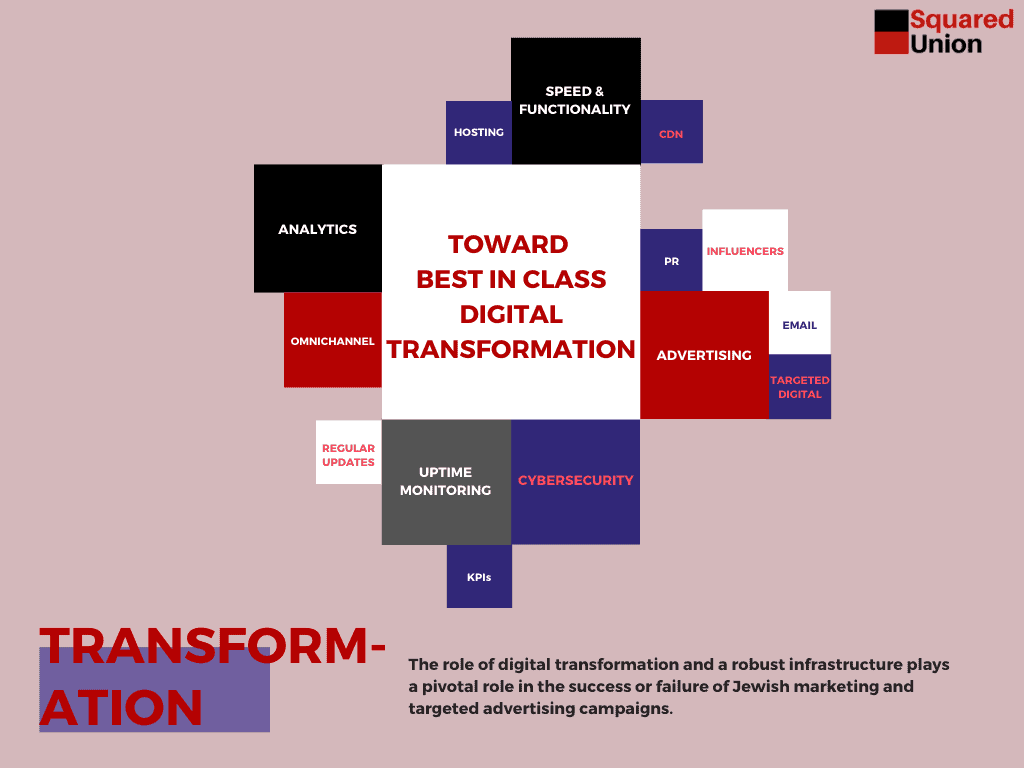The Role Of Digital Transformation
The role of digital transformation and a robust infrastructure plays a pivotal role in the success or failure of Jewish marketing and targeted advertising campaigns. Though it is essential, we find it is often a component of business operations paid insufficient attention. The reasons for the lack of focus on this integral element of any campaign are various. One of the core drivers is simply confusion related to the perceived complexity and overall lack of understanding of digital transformation and what it entails. After all, the term includes many related but separate components that deviate from business to business.
What Does Digital Transformation Entail
Digital transformation includes a whole host of technologies that have transformed business and our lives in general. From the most prominent aspects of digital such as the advent of the internet and e-commerce to the more recent digital developments like AI and automation, this tech has changed everything.
Digital has also had a profound impact on how marketing campaigns are conducted. As we discussed previously, summarising the history of Jewish advertising, we saw a swift shift from analog-based ads to a targeted digital ad universe over the last few years.
Deviation Of Priorities Depending On The Business
It is crucial to keep in mind that because digital transformation encompasses a wide variety of tools and associated strategies, the needs and priorities will vary from one business to the next. For example, a company with a combination of brick and mortar and e-commerce will differ from a web-only retailer. Especially where resources are in short supply, starting with the “lowest hanging fruit” and highest potential initiatives when contrasting cost versus return needs to be the digital transformation theme.
The Competitive Advantage Or Threat
The move toward a digital-first world is an overall and significant net positive. For the consumer, purchases and interactions are more seamless and easy. Businesses can deploy effective and efficient tools that minimize work and expense on various fronts, including actual workforce costs and process streamlining. Those who embark on digital transformation projects that improve their bottom line and overall operational excellence also place themselves at a competitive advantage. Simultaneously, those unable to adapt to the changes found themselves falling behind and sometimes irreparably. As things stand, and especially in light of the COVID-19 pandemic, which has only further accelerated already fast-moving technological progression, businesses’ need to keep up with the times in an agile and adaptive manner is even more critical.
Businesses either unwilling or unable to make the necessary pivots, the danger of being left behind increases dramatically. In our experience, most of the friction to make the required advancements relating to best in class digital transformation is not cost or lack of resources. Instead, it is the very human preference for the status quo and a general aversion to the temporary discomfort that accompanies change.
E-commerce Adoption Has Experienced Years Of Growth In Months
Like many other categories, the pandemic put changes such as e-commerce that were already progressing quite rapidly into a supercharged mode. What would have taken months to effectuate has been accomplished in months. Even for the most stalwart businesses in their slow pace of digital adoption, there was no other choice. Brick and mortars were ordered shut due to the lockdowns leaving e-commerce as their only lifeline to the other side. Even for those who had existing robust digital operations, there was a swift ramping up of capabilities, especially in omnichannel, such as order online and curbside pickup.
The behemoths such as Amazon were massive winners in this new digital-only dynamic. Small businesses that were agile and moved along with consumers’ needs and the present reality also found ways to succeed and even thrive. For some, the pivots were evident while others needed to think out of the box. Regardless, keeping a finger on the pulse of the market and shifting consumer behavior was essential. For example, early in the pandemic, data showed that due to the lockdown and people spending all their time at home, home improvement categories saw elevated demand. We advised a brick-and-mortar only home decor and paint brand to shift to focused online offerings based on these data points. The move included designer consultations via video conference and the incorporation of online design tools into the website’s core functionality. The result was a marked increase in business actually beyond what it was before the crisis.
Every Business Is A Digital Business & The Cloud Is Essential
If there was any doubt previous to the health crisis brought about by the virus, it is clear now that no matter the business type or size, every business is a digital one, and therefore the cloud is essential. Like all-encompassing terms such as “digital transformation,” “the could” is also quite broad in what it refers to. Whether it be cloud computing relating to logistics or communication, business operations are increasingly moving from on-premise to the cloud. This accessibility from anywhere and speed has allowed for the broadening of capabilities on many fronts. Orders can now be placed online, and the customer journey can be fully digital and tracked throughout. Getting a head start on digitizing any business operations that can move the needle and implementing cloud solutions will help propel a best in class functionality.
Speed Moves The Needle
An issue less common with productized websites such as Shopify and Wix and more native to open-source self-managed sites such as WordPress is speed. Site speed is not the top focus area for the budding entrepreneur or e-commerce experimenter. With that said, slow websites can dramatically affect sales and significantly increase cart abandonment rates. There are simple fixes to site speed issues that range from plugins, quality hosting, and content delivery networks with edge computing performance to achieve fast speed on a global scale. Further, site speed and overall user experience (UX) are increasingly playing a leading role in Google’s search rankings, so attaining a fast loading website should be a priority.
High-Quality Digital Infrastructure & Cybersecurity
When choosing the digital infrastructure stack for a business, there is a multitude of options. The necessary components of the mix will also differ depending on the business’s specific needs. The most fundamental aspect of digital infrastructure for any business is the website. The most popular, flexible, and cost-effective choice is WordPress, but at times, such as e-commerce only operations, Shopify may make more sense.
Mostly relevant to WordPress and self-managed web applications is the need for regular updates and cybersecurity measures to ensure digital assets’ stable and smooth functioning. While managed solutions like Shopify have the advantage of automatic and regular updates, there is a tradeoff in functionality and capabilities, especially when it comes to the need for severely limited customizations.
Embedding uptime monitoring and related solutions to ensure that any technical disruptions are promptly brought to the fore and resolved goes a long way to ensuring seamless operations. Choosing quality partners ranging from hosting to tech support will ensure that any downtime is limited in time and frequency.
Robust Analytics & Related Tools
Another often overlooked yet an immensely valuable component of a best in class digital operation includes embedding robust analytics into as many business areas as possible for a real-time and granular view of key performance indicators. From instant inventory updates to enable omnichannel without hiccups, cart abandonment reminders to increase order flow, and related product recommendations to drive larger orders size and regularity, there are various ways to substantially increase the bottom line through analytics and related tools.

